| dc.contributor.advisor | Velásquez Chafloque, Héctor Hugo Gabriel | |
| dc.contributor.author | Montauban del Solar, Michele Marie | es_ES |
| dc.date.accessioned | 2019-05-22T16:41:35Z | es_ES |
| dc.date.available | 2019-05-22T16:41:35Z | es_ES |
| dc.date.created | 2019 | es_ES |
| dc.date.issued | 2019-05-22 | es_ES |
| dc.identifier.uri | http://hdl.handle.net/20.500.12404/14241 | |
| dc.description.abstract | Esta tesis describe y analiza los patrones entonacionales de las oraciones interrogativas
de la variedad del español limeño. Entre los distintos modelos teóricos del análisis de la
entonación, destaca el modelo métrico-autosegmental de Pierrehumbert, que identifica
aquellos elementos cuya combinación origina los contornos melódicos de los
enunciados de una lengua. Para utilizar este modelo, se emplea el sistema de
transcripción fonológica ToBI de Pierrehumbert y Beckman. Su adecuación al modelo
mencionado y simplicidad han permitido su adaptación a varios idiomas, incluido el
español. Existen trabajos análogos para variedades del español como el de Santiago de
Chile, Buenos Aires, Quito, Ciudad de México e, incluso, el español amazónico de
Pucallpa, pero no se ha realizado uno similar para el limeño. El Atlas interactivo de la
entonación del español ofrece algunos de los trabajos mencionados. Para comparar los
enunciados obtenidos con los presentes en el Atlas, se utiliza la encuesta y la
metodología propuestas en este. Se trabaja con ocho colaboradoras que leen
enunciados interrogativos pertinentes a un contexto presentado, de la manera más
espontánea posible. Posteriormente, la información se analiza en el programa Praat y
se etiquetan los acentos tonales y los de frontera, así como las distintas pausas a partir
del sistema de notación Sp_ToBI. Los resultados obtenidos proporcionan un primer
acercamiento descriptivo a los patrones de entonación de las interrogativas en español
limeño. Hasta el momento de escribirse estas líneas, no existe aún un trabajo de estas
características con el español limeño. El tema es importante porque aporta el análisis
prosódico de enunciados de una variedad del español y ofrece información que
permitirá ampliar su conocimiento, dentro de un marco teórico determinado y a partir
de un sistema de representación fonológica ampliamente aceptado. Además, los datos
recogidos y los análisis elaborados permitirán realizar comparaciones posteriores con
otras variedades de español. | es_ES |
| dc.description.abstract | This thesis describes and analyzes the intonational patterns of interrogative sentences
in the Spanish language as spoken in Lima, Peru. Among the theoretical models focusing
on intonation, Pierrehumbert’s autosegmental-metrical model is noteworthy since it
identifies those elements whose combination produces the melodic contours of the
utterances of a language. To use this model, Pierrehumbert and Beckman’s ToBI
phonological transcription system is used. This system’s adjustment to the
aforementioned model and its simplicity have allowed for its adaptation to several
languages, including Spanish. Similar works exist for Spanish as spoken in Santiago de
Chile, Buenos Aires, Quito, Mexico City and Pucallpa, in the Peruvian Amazon – some of
these studies can be found in the Interactive Atlas of Spanish Intonation – but no such
study has been carried out for the Spanish variety spoken in Lima. To compare the
utterances obtained with those present in the Atlas, the survey and the methodology
proposed in it are used. The work is conducted with the help of eight collaborators who
read interrogative statements pertinent to a presented context, in the most
spontaneous way possible. The information was analyzed using the Praat software, and
the pitch accents and boundary tones were labeled using the Sp_ToBI system. The
results obtained here provide a first descriptive approach to the intonation patterns of
interrogative statements in Lima Spanish. As of the completion of this thesis, no study
of similar characteristics has been conducted for this variety. The topic is important since
it offers a prosodic analysis of a variety of Spanish and provides data that will broaden
the knowledge of this variety, within a specific theoretical framework and based on a
widely accepted phonological representation system. The data collected and the
analyses performed will allow for subsequent comparisons with other varieties of
Spanish. | es_ES |
| dc.description.uri | Tesis | es_ES |
| dc.language.iso | spa | es_ES |
| dc.publisher | Pontificia Universidad Católica del Perú | es_ES |
| dc.rights | info:eu-repo/semantics/openAccess | es_ES |
| dc.rights.uri | http://creativecommons.org/licenses/by-nc-sa/2.5/pe/ | * |
| dc.subject | Español--Perú--Entonación | es_ES |
| dc.subject | Español--Perú--Lima | es_ES |
| dc.subject | Entonación (Fonética) | es_ES |
| dc.title | Análisis descriptivo de patrones entonacionales de oraciones interrogativas absolutas, parciales y reiterativas en el español limeño | es_ES |
| dc.type | info:eu-repo/semantics/masterThesis | es_ES |
| thesis.degree.name | Maestro en Lingüística | es_ES |
| thesis.degree.level | Maestría | es_ES |
| thesis.degree.grantor | Pontificia Universidad Católica del Perú. Escuela de Posgrado | es_ES |
| thesis.degree.discipline | Lingüística | es_ES |
| renati.discipline | 232137 | es_ES |
| renati.level | https://purl.org/pe-repo/renati/level#maestro | es_ES |
| renati.type | http://purl.org/pe-repo/renati/type#tesis | es_ES |
| dc.publisher.country | PE | es_ES |
| dc.subject.ocde | https://purl.org/pe-repo/ocde/ford#6.02.06 | es_ES |






